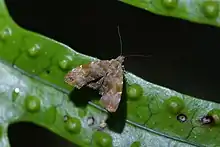| Asterivora colpota | |
|---|---|
 | |
| Scientific classification | |
| Domain: | Eukaryota |
| Kingdom: | Animalia |
| Phylum: | Arthropoda |
| Class: | Insecta |
| Order: | Lepidoptera |
| Family: | Choreutidae |
| Genus: | Asterivora |
| Species: | A. colpota |
| Binomial name | |
| Asterivora colpota | |
| Synonyms[2] | |
| |
Asterivora colpota is a moth in the family Choreutidae.[1] It was first described by Edward Meyrick in 1911. It is endemic to New Zealand and is found throughout the North and South Islands. It is regarded as a lowland species and adults are on the wing from November until March. This moth has been collected by beating shrubs.
Taxonomy
_holotype.jpg.webp)
This species was first described by Edward Meyrick in 1911, using a specimen collected by Alfred Philpott at West Plains in Invercargill, and was named Simaethis colpota.[3] In 1927 Alfred Philpott studied the male genitalia of this species.[4] George Hudson discussed and illustrated this species in his 1928 publication The butterflies and moths of New Zealand.[5] In 1979 J. S. Dugdale placed this species within the genus Asterivora.[6] In 1988 Dugdale confirmed this placement.[2] The holotype female specimen is held at the Natural History Museum, London.[2]
Description
.jpg.webp)
Meyrick described this species as follows:
♀. 13mm. Head and thorax dark bronzy-fuscous sprinkled with whitish. Palpi with whorls of dark-fuscous scales tipped with white, second joint with rough projecting scales, whitish towards base beneath. Antennae black ringed with white. Abdomen blackish-fuscous, segmental margins brownish. Forewings elongate, rather dilated posteriorly, costa slightly arched, apex obtuse, termen bowed, rather oblique; dark bronzy-fuscous, basal and terminal areas finely sprinkled with whitish; two parallel rather curved irregular transverse lines of whitish irroration about 2⁄5; a transverse line of whitish irroration from a white mark on costa at 3⁄5, its upper 2⁄3 forming a strong irregular curve outwards, thence right-angled to dorsum at 3⁄5; its upper 2⁄3 forming a strong irregular curve outwards, thence right-angled to dorsum at 3⁄5; a transverse linear mark of whitish irroration terminated beneath by a white dot lying within this curve and almost touching it at both ends; a thick subterminal shade of whitish irroration, somewhat interrupted above middle: cilia dark fuscous with some whitish points, beneath apex and above tornus with some whitish points, beneath apex and above tornus with white apical patches. Hindwings dark grey, terminal half blackish; two parallel lines of whitish irroration towards termen on lower half, posterior less marked: cilia dark fuscous with blackish subbasal shade, beyond this suffused with whitish on lower half of termen.[3]
Meyrick stated that this species was similar in appearance to Asterivora combinatana but that it could be distinguished from it via the discal mark as well as the second line on the forewings.[3]
Distribution
This species is endemic to New Zealand and can be found throughout the North and South Islands.[1][7]
Habitat
This species is regarded as living in lowland habitat.[8]
Behaviour
This species is on the wing from November until March.[5][9] This moth has been collected by beating shrubs.[10]
References
- 1 2 3 Gordon, Dennis P., ed. (2010). New Zealand inventory of biodiversity: Kingdom animalia: chaetognatha, ecdysozoa, ichnofossils. Vol. 2. p. 457. ISBN 978-1-877257-93-3. OCLC 973607714. OL 25288394M. Wikidata Q45922947.
- 1 2 3 John Stewart Dugdale (23 September 1988). "Lepidoptera - annotated catalogue, and keys to family-group taxa". Fauna of New Zealand. Department of Scientific and Industrial Research. 14: 113. doi:10.7931/J2/FNZ.14. ISSN 0111-5383. Wikidata Q45083134.
- 1 2 3 E. Meyrick (1 July 1911). "Notes and Descriptions of New Zealand Lepidoptera". Transactions and Proceedings of the New Zealand Institute. 43: 67. ISSN 1176-6158. Wikidata Q58200989.
- ↑ Alfred Philpott (15 November 1927). "The Male Genitalia of the New Zealand Glyphipterygidae". Transactions and Proceedings of the New Zealand Institute. 58: 337–347. ISSN 1176-6158. Wikidata Q110772020.
- 1 2 George Vernon Hudson (1928), The butterflies and moths of New Zealand, Illustrator: George Hudson, Wellington: Ferguson and Osborn Limited, p. 308, LCCN 88133764, OCLC 25449322, Wikidata Q58593286
- ↑ J. S. Dugdale (July 1979). "A new generic name for the New Zealand species previously assigned to Simaethis auctorum (Lepidoptera: Choreutidae), with description of a new species". New Zealand Journal of Zoology. 6 (3): 265. doi:10.1080/03014223.1979.10428386. ISSN 0301-4223. Wikidata Q54576372.
- ↑ "Asterivora colpota Meyrick, 1911". www.gbif.org. Retrieved 2022-02-03.
- ↑ B. I. P. Barratt; B. H. Patrick (January 1987). "Insects of snow tussock grassland on the East Otago Plateau". New Zealand Entomologist. 10 (1): 69–98. doi:10.1080/00779962.1987.9722513. ISSN 0077-9962. Wikidata Q54576207.
- ↑ Alan Emmerson; Robert Hoare (28 October 2019). "Lepidoptera from Redvale, Albany, north of Auckland, New Zealand, 2004-2016: an annotated list". The Wētā. 53: 63. ISSN 0111-7696. Wikidata Q105342215.
- ↑ T. H. Davies (January 1973). "LIST OF LEPIDOPTERA COLLECTED IN AREAS SURROUNDING HASTINGS AND NAPIER" (PDF). New Zealand Entomologist. 5 (2): 206. doi:10.1080/00779962.1973.9723002. ISSN 0077-9962. Wikidata Q54755566. Archived from the original (PDF) on 9 February 2013.